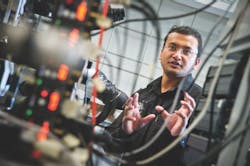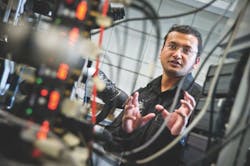New biophotonics advances map the brain, guide axons
A University of Texas at Arlington physics team is using their biophotonics expertise to advance new methods in areas such as mapping the neural circuitry of the brain and guiding neurons to potentially repair damage in the body.
Related: The BRAIN Initiative: Opportunities for optics and photonics
Samarendra Mohanty, an assistant professor of physics, leads the Biophysics and Physiology Lab in the UT Arlington College of Science. He is co-author on two papers published this month. In one published by the online journal PLoS One, researchers in his lab described using a method called “two-photon optogenetic stimulation” to carry out in-depth optogenetic stimulation of brain neurons in mouse models—a first in vivo example of the technology.
The second paper was published by Nature Scientific Reports and details how scientists used weakly focused, near-infrared (NIR) laser beams to guide axons to form loops on itself, termed as self-fasciculation, in the lab. Axons are the shafts of neurons, on the tips of which connections are made with other neurons or cells.
Kamal R. Dhakal, a PhD student working in Mohanty's lab, is lead author on the PLoS One paper, which is called “Non-scanning fiber-optic near infrared beam led two-photon optogenetic stimulation in-vivo.” The research paper describes using NIR light delivered by fiber optics to stimulate a light-sensitive protein called ChR2 that can be delivered into living cells and neurons. Last month, Dhakal and Bryan Black in the Mohanty lab reported in Nature Scientific Reports the use of NIR laser beam to stain neurons with impermeable molecules to visualize neural connectivity.
These technologies would be useful in brain mapping initiatives championed by the scientific community and President Barack Obama. Eventually, researchers hope more knowledge about neural circuitry in the brain could lead to new treatments for conditions such as chronic pain and drug addiction.
“Scientists are trying to find out about the connectivity of neuronal circuitry in different regions of the brain, but that information is not sufficient, unless we examine how those connections function. That's where two-photon optogenetics comes into play,” Dhakal says.
Because the fiber-optic two-photon optogenetic stimulation (FO-TPOS) uses NIR light instead of a visible beam, it can surpass the penetration abilities a conventional single-photon beam that uses visible light, Mohanty says. The FO-TPOS also avoids tissue damage that would be caused by using electrical pulses to map circuitry, another previous method.
To view the PLoS One paper, please visit http://dx.doi.org/10.1371/journal.pone.0111488.
The Nature Scientific Reports paper, “Loop formation and self-fasciculation of cortical axon using photonic guidance at long working distance,” builds on previous work the lab has done using NIR laser beams to guide axon growth, both by pushing and pulling the growth area or "growth cone."
Mohanty says the paper demonstrates the first use of light, or any other method, to achieve looping or bundling of axon on itself. It is available at http://dx.doi.org/10.1038/srep06902.
Mohanty's lab is currently supported by a $384,269 two-year grant from the National Institutes of Health National Institute of Neurological Disorders and Strokes.
-----
Follow us on Twitter, 'like' us on Facebook, connect with us on Google+, and join our group on LinkedIn
Subscribe now to BioOptics World magazine; it's free!

